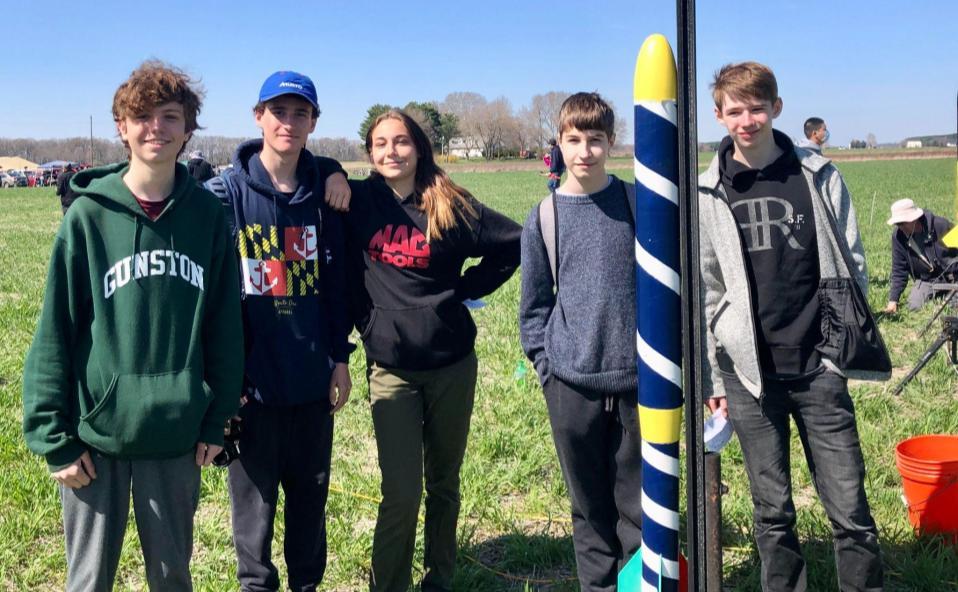The Gunston School sent 10 students in four teams with five rockets to the 2022 Red Glare Rocket Festival in Price, Md., sponsored by the Maryland Delaware Rocketry Association (MDRA). The American Rocketry Challenge (TARC) at Gunston is one of the main projects of the Science and Engineering Club, mentored by the Chair of the Science Department, Dr. Ken Wilson. Oliver White ’23 (Easton, Md.) is this year’s “rocketry tsar,” whose job is to organize the team along with fellow student leaders Autumn Watson ’23 (Centreville, Md.), Josh Nuessle ’24 (Centreville, Md.), and Colin Lang ’22 (Trappe, Md.)
This year’s challenge (per TARC website) was to build a model rocket that carried two raw large hen eggs (mounted sideways) to an altitude of 835 feet, stayed airborne for between 41 and 44 seconds, and returned to ground safely. Other requirements for the rocket included “a gross liftoff weight of no more than 650 grams, a minimum length of at least 650 millimeters, be made up of body tubes of two different diameters and be powered by commercial rocket motor(s) of class “F” or smaller with no more than 80 N-sec of total impulse across all motors.”

(L-R) Josh Nuessle ’24, Tommy McGeady ’25, Emma Sharp ’25, Justin MCubbin ’25, and Alex McIntyre ’25.
“The day got off to an intense start, as there were quite a lot of finishing touches to be added on Saturday morning,” said Dr. Wilson. “But the teams were able to get their rockets through inspection and out onto the field.”
Nuessle’s team included Alex McIntyre ’25 (Crofton, Md.), Tommy McGeady ’25 (Arnold, Md.), Justin McCubbin ’25 (Severna Park, Md.), and Emma Sharp ’25 (Chestertown, Md.) The team’s rocket, “The Lighthouse,” flew beautifully for its third-ever flight and gained a good set of data to study despite the hard landing. Sharp also launched her “Big Bertha” rocket for the third time which performed flawlessly.
The team led by Watson also included Yining Wei ’25 (Guangzhou, China), and Trevor Janssen ’25 (Stevensville, Md.). Their rocket, dubbed the “Ankle Biter,” flew well on its very first flight. The nose cone detached during recovery, but was retrieved and repaired. “I’m impressed that they were able to cooperate to build a first class rocket without ever being able to work together in person,” said Dr. Wilson, who is referring to the fact that students used their free time to build rockets after school and on weekends, so rockets often had a rotating cast of characters (students), who weren’t always able to work together at the same time.
Lang’s ambitious team—Jian “Daniel” Dang ’22 (Zhengzhou, China), Jiacheng “Jason” Ye ’23 (Suzhou, China), and Robert Crow ’22 (Friendship, Md.)—elected to skip the TARC requirements and create “Big Blue,” the largest, heaviest rocket that Gunston has ever built. It flew into the sky successfully during trials at the school and at Red Glare, however it experienced a recovery system glitch both times. Still, it was recovered practically undamaged. “The size and design of the rocket raised eyebrows during inspection, and it was gratifying to see it achieve stable flight,” added Dr. Wilson.

Matthew Sharpless ’22, Oliver White ’23, and Kate Kroncke ’23 with “Mustard” (the first rocket).
The last team to offer up a rocket to compete at Red Glare was White’s team including Kate Kroncke ’23 (Grasonville, Md.), Paige Kroncke ’23 (Grasonville, Md.), Aidan Watson ’25 (Centreville, Md.), Alex Bent ’25 (Queenstown, Md.), and Matthew Sharpless ’22 (Easton, Md.), none of whom were able to attend the event this year. Two weeks prior, the team’s rocket was destroyed in a test launch, due to a catastrophic motor failure.
“They dug in and pulled together a simpler rocket in record time as a replacement,” explained Dr. Wilson. “Alex McIntyre generously agreed to take it through inspection and launch it for them. Unfortunately, the electronics of the launch pad supplied by Red Glare failed and their replacement rocket did not get a chance to make its first flight despite two tries. Oliver’s team will launch it at Gunston in the coming weeks.”
Dr. Wilson continued, “Congratulations to all the hard working students participating in TARC rocketry at Gunston this year, and many thanks to the parents who made it possible for students to meet over weekends to design, simulate, build, and launch rockets. It is worth noting that the majority of rockets in their size range at Red Glare were built from kits; building a stable rocket from scratch is a much more challenging task! The students and I learned a lot this year and I can’t wait to see our newly minted rocketry experts mentor the next generation of newbies next year!”
Head of School John Lewis added, “I am very excited to see the huge growth in interest in our STEM programs here at Gunston. In 2017, we had three students, one team, and one rocket. This year, the program was full with 18 students, some completely new to the program. What they were all able to accomplish is a testament to Dr. Wilson, and I can’t wait to see the program grow even more.”
Founded in 1911, The Gunston School is an independent, nonprofit, nonsectarian, coeducational, college preparatory high school located in Centreville, Maryland. Visit gunston.org for more information.



Write a Letter to the Editor on this Article
We encourage readers to offer their point of view on this article by submitting the following form. Editing is sometimes necessary and is done at the discretion of the editorial staff.